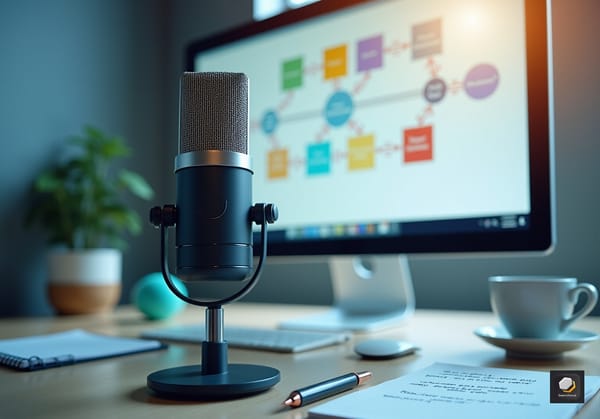Understanding AI SDR: Definition, Evolution, and Impact
Discover how AI SDR transforms sales development through automation, efficiency, and data-driven insights.

Key Highlights:
- AI SDRs are software solutions that automate tasks like lead generation, qualification, and outreach, enhancing sales efficiency.
- The technology employs natural language processing (NLP) and machine learning to analyse data and engage with potential customers.
- Growing reliance on AI SDRs is evident, with 40% of executives planning to increase AI budgets for sales development.
- Key features include real-time data analysis, automated communications, and insights into customer behaviour.
- AI SDR technology is projected to grow significantly, from $18.58 billion in 2023 to $67.36 billion by 2030, indicating increasing dependence on AI for customer acquisition.
- AI SDRs improve engagement through personalised outreach, leading to higher conversion rates compared to traditional methods.
- The implementation of AI SDRs results in increased efficiency and enhanced prospect qualification, allowing teams to focus on strategic activities.
- Challenges include integration issues with existing systems, the need for high-quality data, and balancing automation with personal interaction.
- Successful AI SDR adoption requires addressing internal resistance and ensuring AI complements human representatives rather than replacing them.
Introduction
The rise of Artificial Intelligence in sales has initiated a transformative shift, redefining the roles traditionally held by Sales Development Representatives (SDRs). As businesses increasingly adopt AI-driven solutions, the efficiency and effectiveness of lead generation and customer engagement are being revolutionised. This article explores the intricacies of AI SDRs, examining their evolution, core functionalities, and the significant impact they have on sales teams. However, as organisations embrace this technology, they must navigate the challenges of integration while balancing automation with the personal touch essential for fostering lasting customer relationships.
Define AI SDR: The Basics of Automated Sales Development Representatives
AI SDR, or Artificial Intelligence Sales Development Representative, describes software solutions that leverage AI SDR technology to perform tasks traditionally managed by human development representatives. These tasks include lead generation, qualification, and outreach, enabling businesses to optimise their sales processes. By leveraging natural language processing (NLP) and machine learning algorithms, AI sales development representatives can analyse data, engage with potential customers, and automate repetitive tasks, thereby enhancing efficiency and productivity within sales teams.
Current trends indicate a growing reliance on AI SDR, with numerous organisations recognising the potential of AI SDR to transform business operations. Companies are increasingly adopting AI tools to refine lead generation and qualification processes, allowing human representatives to concentrate on more strategic initiatives. The integration of AI in commerce not only accelerates outreach efforts but also ensures that interactions are more personalised and data-driven.
Key features of AI SDR technology encompass the ability to analyse customer data in real-time, automate follow-up communications, and provide insights into customer behaviour. These capabilities empower sales teams to make informed decisions and tailor their strategies to meet the specific needs of prospective clients.
Industry leaders emphasise the importance of embracing AI for revenue growth. For example, Gail Moody-Byrd, LinkedIn's Marketing VP, highlighted that generative AI can enhance 59% of selling capabilities, underscoring the technology's potential to augment human skills rather than replace them. Furthermore, Aneesh Raman from LinkedIn asserted that AI is poised to revolutionise every aspect of business, including how sellers sell and buyers buy. As organisations continue to adapt to the evolving landscape of commerce, the role of AI SDR is becoming increasingly vital in driving efficiency and achieving business objectives. Moreover, with 40% of executives planning to increase their AI budgets, the necessity of investing in AI technologies for sales development is unmistakable.
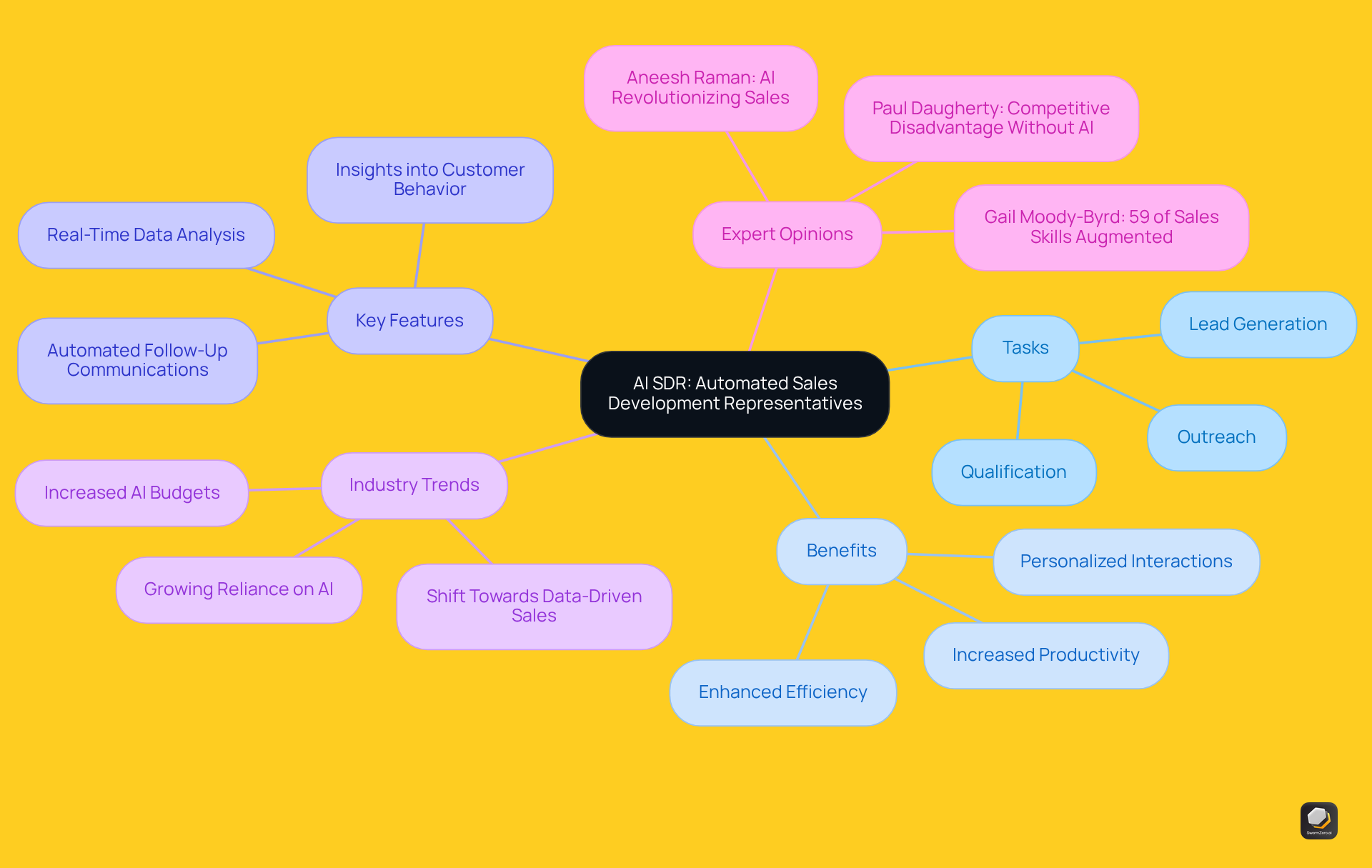
Trace the Evolution: From Human SDRs to AI-Driven Solutions
The role of Sales Development Representatives has undergone a remarkable transformation over the past two decades. Initially, SDRs focused primarily on cold calling and prospect qualification, heavily relying on manual methods that often hampered efficiency. However, the advent of digital marketing and data analytics underscored the need for more effective prospect management strategies. As a result, AI SDR technologies, particularly those offered by SwarmZero, have revolutionised this domain by automating numerous tasks that were previously performed by human SDRs.
Today, the SwarmZero platform is utilised by AI SDRs, which leverage advanced algorithms and features like automated prospect scoring and personalised messaging tools to analyse vast datasets. This capability allows them to pinpoint high-quality leads with precision and engage prospects through tailored communications, significantly boosting the chances of conversion. Furthermore, AI SDR solutions can automate meeting scheduling, thereby streamlining business processes and enabling human teams to focus on strategic initiatives.
Statistics underscore this evolution: companies that have integrated AI into their revenue processes report substantial gains in efficiency and effectiveness. For example, organisations like Forcura have seen a 200% increase in lead-to-sales meeting conversions after implementing AI-driven solutions, illustrating the tangible advantages of this technological shift. As digital marketing continues to reshape the commercial landscape, the role of sales development representatives is increasingly defined by their ability to harness AI SDR tools, such as those provided by the SwarmZero platform, marking a significant departure from traditional methods.
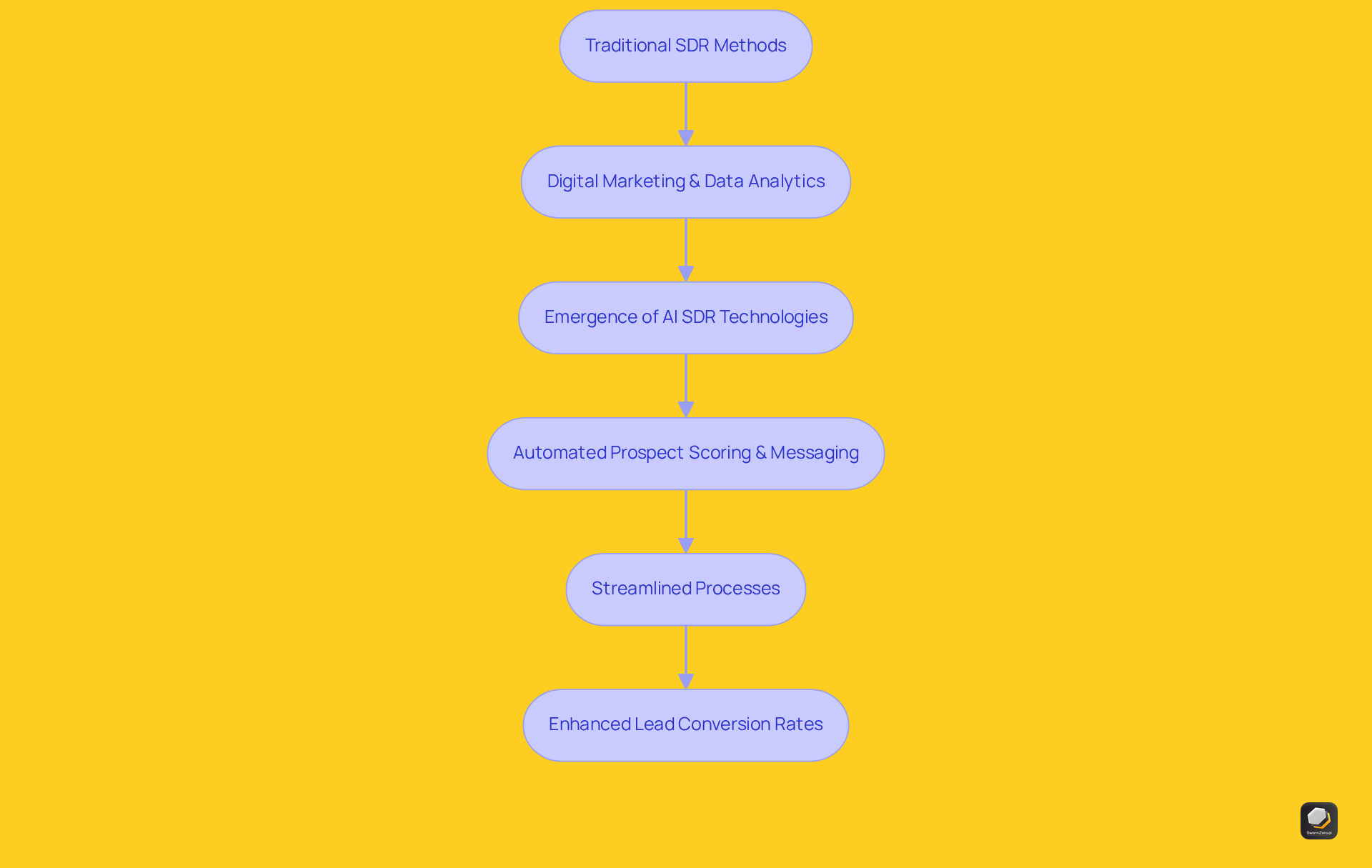
Explore Functions: Key Responsibilities and Capabilities of AI SDRs
AI SDRs possess a diverse array of capabilities that significantly enhance their effectiveness in sales development. Their key responsibilities encompass:
-
Lead Generation: AI SDRs automatically identify and qualify leads based on predefined criteria, drastically reducing the time spent on manual research. This automation is essential, particularly as the AI SDR market is forecasted to expand from $18.58 billion in 2023 to $67.36 billion by 2030, demonstrating a compound annual growth rate (CAGR) of 20.2% from 2024 to 2030. This trend signifies the growing dependence on AI SDR for customer acquisition.
-
Personalised Outreach: Through Natural Language Processing (NLP), AI sales development representatives craft customised messages tailored for individual prospects. This strategy has been shown to improve engagement rates, with companies utilising AI-powered personalisation experiencing up to a sevenfold increase in conversion rates compared to traditional methods.
-
Data Analysis: These systems analyse customer interactions and feedback to refine outreach strategies and enhance lead scoring. By leveraging advanced data analytics, AI sales development representatives can identify stalled agreements and recognise potential risks within the revenue pipeline, enabling teams to take proactive actions.
-
Scheduling and Follow-ups: AI sales development representatives automate the scheduling of meetings and follow-up communications, ensuring timely engagement with prospects. This capability is vital in a landscape where conversion rates have declined due to increased email volume and decreased quality, as AI-driven tools help maintain consistent communication.
-
Integration with CRM Systems: They seamlessly integrate with existing Customer Relationship Management (CRM) systems, facilitating real-time updates and data sharing across platforms. However, companies may encounter difficulties in ensuring compatibility with existing revenue systems, which is essential for maximising the potential of AI sales development representatives.
By automating prospect research, tailored outreach, and follow-up activities, AI SDRs empower teams to focus on cultivating relationships and advancing deals, ultimately driving increased revenue growth. As Elizabeth Jortberg observes, "AI sales development resources have become a crucial aspect of contemporary sales processes, not by substituting personal representatives, but by enhancing their capacity to connect with valuable prospects more efficiently." Additionally, organisations must acknowledge potential internal resistance to adopting AI technology due to job security concerns, which can impact the successful implementation of these tools.
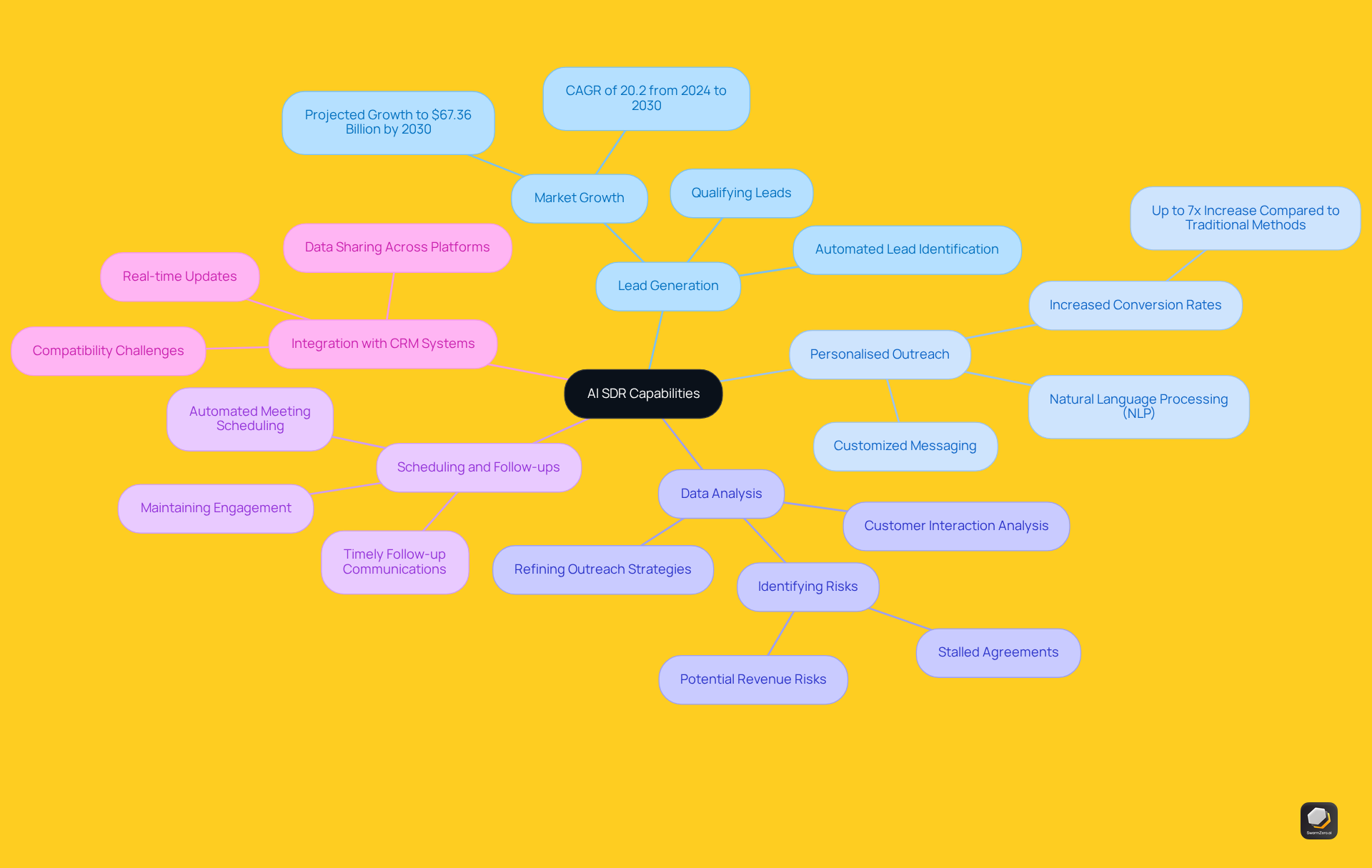
Evaluate Benefits and Challenges: The Impact of AI SDRs on Sales Teams
The implementation of AI Sales Development Representatives (SDRs) offers numerous advantages for sales teams:
- Increased Efficiency: Automating repetitive tasks allows human representatives to focus on high-value activities, such as closing deals and nurturing relationships. This shift empowers teams to engage in strategic account planning and consultative conversations, ultimately enhancing overall engagement quality.
- Enhanced Prospect Qualification: AI-driven analytics significantly improve scoring accuracy, ensuring that sales teams prioritise the most promising candidates. This intelligent prospect prioritisation enables sales development representatives to concentrate their efforts on opportunities with the greatest potential for conversion, thereby enhancing outreach efficiency.
- Cost Savings: Organisations can achieve substantial reductions in labour costs associated with traditional SDR roles while maintaining or even increasing lead generation capabilities. An AI SDR can manage outreach equivalent to two or three traditional representatives, amplifying scalability and return on investment.
However, several challenges accompany the adoption of AI SDRs:
- Integration Issues: Implementing AI SDRs often necessitates significant adjustments to existing workflows and systems, which can disrupt established processes. Ensuring compatibility with current customer relationship management systems is crucial for a smooth transition. Additionally, internal resistance to AI adoption can pose challenges, requiring clear communication about the supportive role of AI.
- Data Quality: The effectiveness of AI SDRs hinges on the quality of the data they analyse. Poor data can lead to ineffective outreach and missed opportunities, underscoring the importance of maintaining high data standards for successful implementation.
- AI Collaboration with People: Striking the right balance between automation and personal interaction is essential. Over-reliance on AI can diminish the personal touch in sales communications, vital for building trust and rapport with prospects. As Eric Xiao notes, "AI should not be used as a way to replace the people on your team but to enhance their capabilities." Human SDRs excel in scenarios requiring emotional intelligence and deep customer relationships, highlighting the need for a balanced approach where AI complements rather than replaces human efforts.
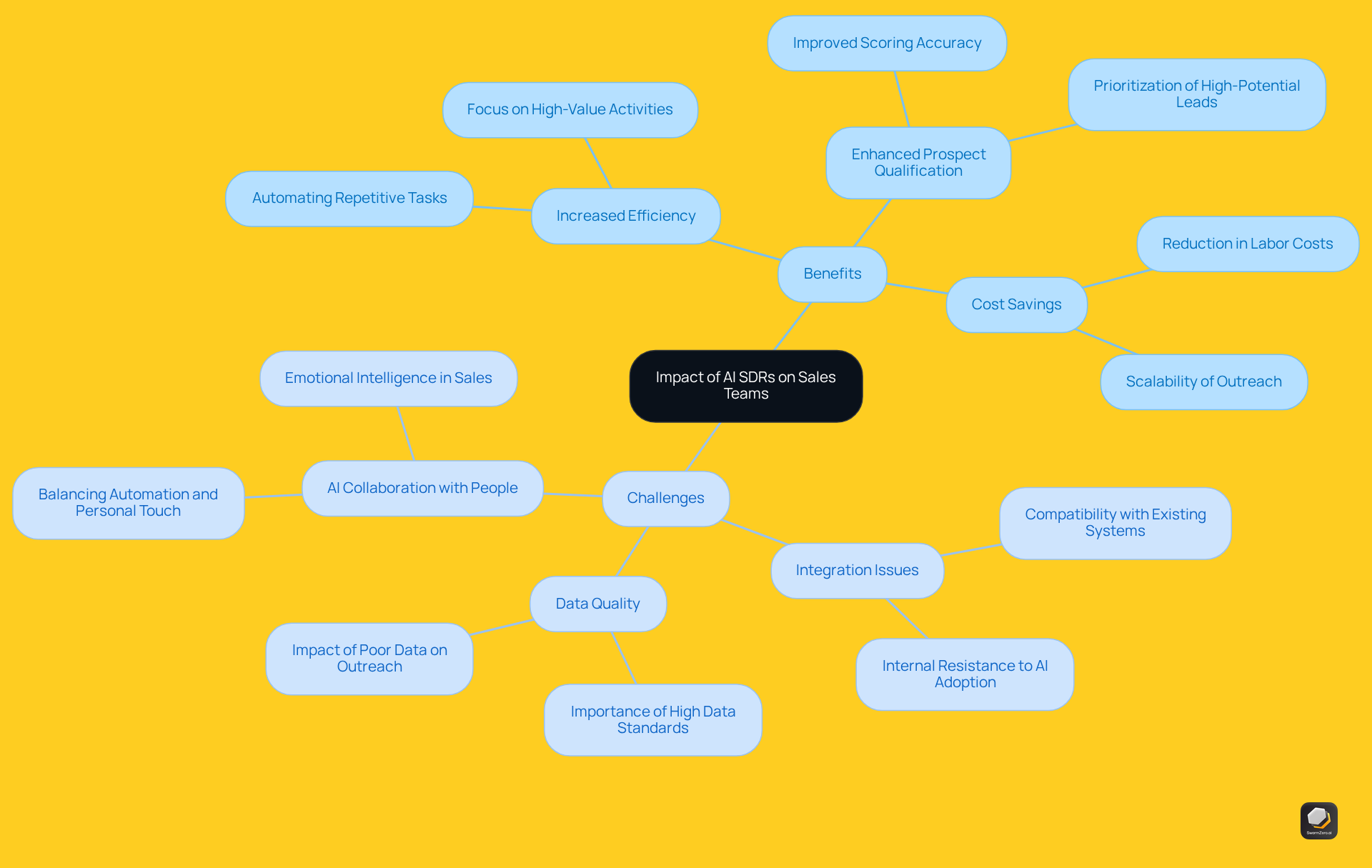
Conclusion
The emergence of AI Sales Development Representatives (AI SDRs) signifies a pivotal shift in how businesses approach sales processes. By automating tasks traditionally managed by human representatives, AI SDRs enhance efficiency and empower sales teams to focus on strategic initiatives that drive growth. This transformation illustrates the profound impact of integrating artificial intelligence into sales development, enabling a more data-driven and personalised engagement with potential customers.
Key insights throughout the article highlight the evolution of AI SDRs from their human counterparts, showcasing their capabilities in lead generation, personalised outreach, and data analysis. The benefits of implementing AI SDRs are evident:
- Increased efficiency
- Enhanced prospect qualification
- Significant cost savings
However, challenges such as integration issues and the need for high-quality data must be navigated to fully realise the potential of these technologies. The balance between automation and the human touch remains crucial in maintaining strong relationships with prospects.
As businesses continue to adapt to the dynamic landscape of sales, embracing AI SDRs is not merely a trend but a necessary evolution. Organisations are encouraged to invest in these technologies to streamline their processes and enhance overall sales performance. By leveraging AI SDRs, companies can unlock new opportunities for growth and establish a competitive edge in an increasingly automated world.
Frequently Asked Questions
What is an AI SDR?
AI SDR, or Artificial Intelligence Sales Development Representative, refers to software solutions that use AI technology to perform tasks typically handled by human sales development representatives, such as lead generation, qualification, and outreach.
How does AI SDR improve sales processes?
AI SDR enhances sales processes by automating repetitive tasks, allowing businesses to optimise their operations. It leverages natural language processing (NLP) and machine learning algorithms to analyse data, engage with potential customers, and streamline outreach efforts.
What are the current trends regarding AI SDR?
There is a growing reliance on AI SDR, with many organisations recognising its potential to transform business operations. Companies are increasingly adopting AI tools to refine lead generation and qualification processes, enabling human representatives to focus on more strategic initiatives.
What key features does AI SDR technology offer?
Key features of AI SDR technology include real-time customer data analysis, automated follow-up communications, and insights into customer behaviour, which help sales teams make informed decisions and tailor their strategies.
How does AI SDR impact the role of human sales representatives?
AI SDR is designed to augment human skills rather than replace them. It allows human representatives to concentrate on strategic initiatives while AI handles repetitive tasks, thereby enhancing overall productivity.
What do industry leaders say about the importance of AI in sales?
Industry leaders emphasise that embracing AI is crucial for revenue growth. For instance, Gail Moody-Byrd from LinkedIn stated that generative AI can enhance 59% of selling capabilities, while Aneesh Raman noted that AI is set to revolutionise how sellers sell and buyers buy.
Are organisations planning to invest more in AI technologies for sales development?
Yes, approximately 40% of executives plan to increase their AI budgets, highlighting the necessity of investing in AI technologies to enhance sales development efforts.
List of Sources
- Define AI SDR: The Basics of Automated Sales Development Representatives
- How to Think About AI in Sales: 12 Quotes Worth Considering (https://linkedin.com/business/sales/blog/strategy/ai-in-sales-quotes-from-leaders-on-how-to-think-about-it)
- 28 Best Quotes About Artificial Intelligence | Bernard Marr (https://bernardmarr.com/28-best-quotes-about-artificial-intelligence)
- 25 Motivational Sales Quotes from Revenue.io and Top Industry Leaders (https://revenue.io/blog/motivational-sales-quotes-from-revenue-and-top-industry-leaders)
- 75 Quotes About AI: Business, Ethics & the Future (https://deliberatedirections.com/quotes-about-artificial-intelligence)
- Trace the Evolution: From Human SDRs to AI-Driven Solutions
- Forcura scales up with Growth Era and increases pipeline velocity by 200% (https://growthera.com/case_studies/forcura)
- Sales Support Website Case Study (https://monkeytag.com/case_studies/sales-support-website-case-study)
- Explore Functions: Key Responsibilities and Capabilities of AI SDRs
- What Sales Teams Should Know To Use AI SDRs Successfully (https://forbes.com/councils/forbesbusinesscouncil/2024/10/02/what-sales-teams-should-know-to-use-ai-sdrs-successfully)
- 2024 Saw the Rise of the AI SDR. In 2025, Agentic AI Will Go Further and Transform GTM Strategies Forever | Landbase (https://landbase.com/blog/2024-saw-the-rise-of-the-ai-sdr-in-2025-agentic-ai-will-go-further-and-transform-gtm-strategies-forever)
- State of AI SDR 2025 (https://superrep.ai/blog/state-of-ai-sdr)
- The Role of AI in Sales Development: How AI SDR Tools Support Human Reps (https://nooks.ai/blog-posts/the-role-of-ai-in-sales-development-how-ai-sdr-tools-support-human-reps)
- Future of Sales: How AI Inbound SDRs Are Redefining Pipeline Creation and Lead Qualification in 2025 - SuperAGI (https://superagi.com/future-of-sales-how-ai-inbound-sdrs-are-redefining-pipeline-creation-and-lead-qualification-in-2025)
- Evaluate Benefits and Challenges: The Impact of AI SDRs on Sales Teams
- What Sales Teams Should Know To Use AI SDRs Successfully (https://forbes.com/councils/forbesbusinesscouncil/2024/10/02/what-sales-teams-should-know-to-use-ai-sdrs-successfully)
- AI in Sales Development: How AI SDRs are Reshaping B2B Sales (https://coldiq.com/blog/ai-sales-development-sdr)
- Unpacking the Benefits of AI for SDR Teams: Redefining the Role (https://demandspring.com/blog/benefits-of-ai-for-sdr-teams-smarter-sales-outreach)
- AI-SDRs and the Future of B2B Sales: Risks vs. Rewards (https://tbtech.co/business/ai-sdrs-and-the-future-of-b2b-sales-risks-vs-rewards)
- Pros and cons of AI SDRs: Everything you need to know about how AI is changing sales development (https://folk.app/articles/pros-and-cons-of-ai-sdrs-everything-you-need-to-know-about-how-ai-is-changing-sales-development)


